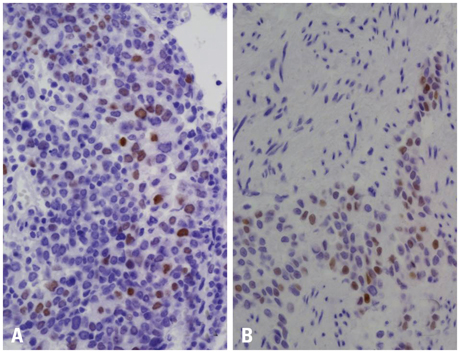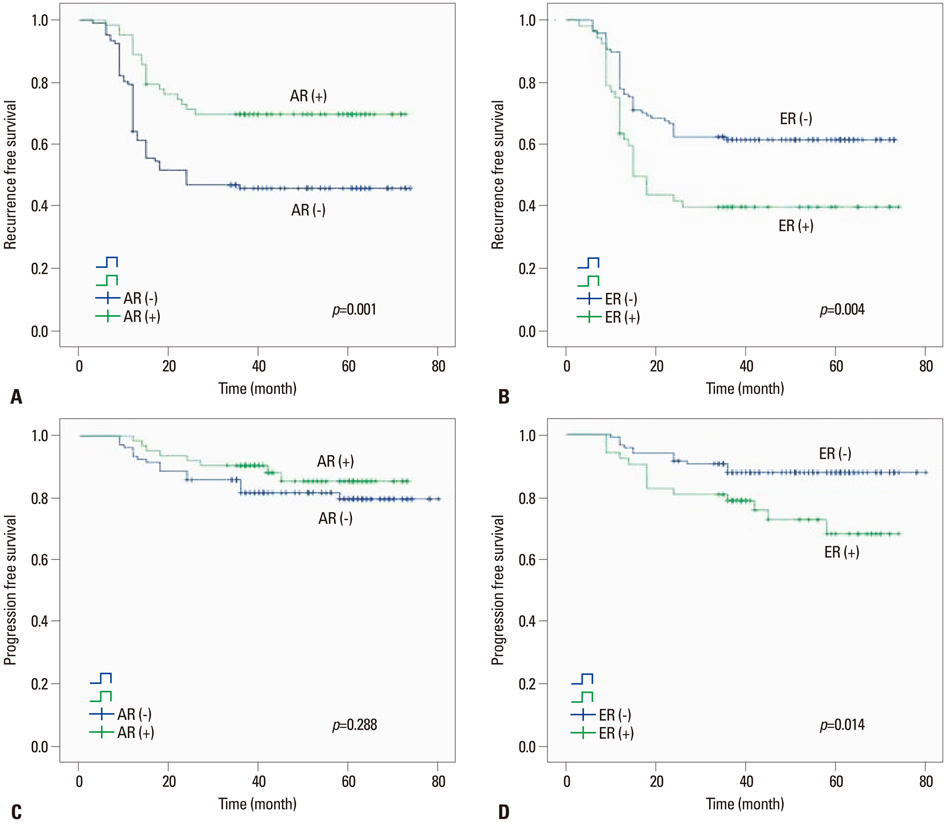Yonsei Med J.
2014 Sep;55(5):1214-1221. 10.3349/ymj.2014.55.5.1214.
Prognostic Value of Sex-Hormone Receptor Expression in Non-Muscle-Invasive Bladder Cancer
- Affiliations
-
- 1Department of Urology, Research Institute for Convergence of Biomedical Science and Technology, Pusan National University Yangsan Hospital, Pusan National University School of Medicine, Yangsan, Korea. toughkil76@naver.com
- KMID: 1799483
- DOI: http://doi.org/10.3349/ymj.2014.55.5.1214
Abstract
- PURPOSE
We investigated sex-hormone receptor expression as predicting factor of recurrence and progression in patients with non-muscle invasive bladder cancer.
MATERIALS AND METHODS
We retrospectively evaluated tumor specimens from patients treated for transitional cell carcinoma of the bladder at our institution between January 2006 and January 2011. Performing immunohistochemistry using a monoclonal androgen receptor antibody and monoclonal estrogen receptor-beta antibody on paraffin-embedded tissue sections, we assessed the relationship of immunohistochemistry results and prognostic factors such as recurrence and progression.
RESULTS
A total of 169 patients with bladder cancer were evaluated in this study. Sixty-threepatients had expressed androgen receptors and 52 patients had estrogen receptor beta. On univariable analysis, androgen receptor expression was significant lower in recurrence rates (p=0.001), and estrogen receptor beta expression was significant higher in progression rates (p=0.004). On multivariable analysis, significant association was found between androgen receptor expression and lower recurrence rates (hazard ratio=0.500; 95% confidence interval, 0.294 to 0.852; p=0.011), but estrogen receptor beta expression was not significantly associated with progression rates.
CONCLUSION
We concluded that the possibility of recurrence was low when the androgen receptor was expressed in the bladder cancer specimen and it could be the predicting factor of the stage, number of tumors, carcinoma in situ lesion and recurrence.
MeSH Terms
-
Adult
Aged
Aged, 80 and over
Carcinoma, Transitional Cell/*metabolism/pathology
Disease Progression
Disease-Free Survival
Female
Humans
Male
Middle Aged
Multivariate Analysis
Neoplasm Invasiveness
Prognosis
Receptors, Androgen/*metabolism
Receptors, Estrogen/*metabolism
Retrospective Studies
Risk Factors
Tumor Markers, Biological/*metabolism
Urinary Bladder Neoplasms/*metabolism/pathology
Young Adult
Receptors, Androgen
Receptors, Estrogen
Tumor Markers, Biological
Figure
Reference
-
1. Negri E, La Vecchia C. Epidemiology and prevention of bladder cancer. Eur J Cancer Prev. 2001; 10:7–14.
Article2. Scosyrev E, Noyes K, Feng C, Messing E. Sex and racial differences in bladder cancer presentation and mortality in the US. Cancer. 2009; 115:68–74.
Article3. Scosyrev E, Trivedi D, Messing E. Female bladder cancer: incidence, treatment, and outcome. Curr Opin Urol. 2010; 20:404–408.
Article4. Cantor KP, Lynch CF, Johnson D. Bladder cancer, parity, and age at first birth. Cancer Causes Control. 1992; 3:57–62.
Article5. Okajima E, Hiramatsu T, Iriya K, Ijuin M, Matsushima S. Effects of sex hormones on development of urinary bladder tumours in rats induced by N-butyl-N-(4-hydroxybutyl) nitrosamine. Urol Res. 1975; 3:73–79.6. Imada S, Akaza H, Ami Y, Koiso K, Ideyama Y, Takenaka T. Promoting effects and mechanisms of action of androgen in bladder carcinogenesis in male rats. Eur Urol. 1997; 31:360–364.
Article7. Wilson CM, McPhaul MJ. A and B forms of the androgen receptor are expressed in a variety of human tissues. Mol Cell Endocrinol. 1996; 120:51–57.
Article8. Celayir S, Ilçe Z, Dervisoglu S. The sex hormone receptors in the bladder in childhood - I: preliminary report in male subjects. Eur J Pediatr Surg. 2002; 12:312–317.
Article9. Shen SS, Smith CL, Hsieh JT, Yu J, Kim IY, Jian W, et al. Expression of estrogen receptors-alpha and -beta in bladder cancer cell lines and human bladder tumor tissue. Cancer. 2006; 106:2610–2616.
Article10. Tuygun C, Kankaya D, Imamoglu A, Sertcelik A, Zengin K, Oktay M, et al. Sex-specific hormone receptors in urothelial carcinomas of the human urinary bladder: a comparative analysis of clinicopathological features and survival outcomes according to receptor expression. Urol Oncol. 2011; 29:43–51.
Article11. Madeb R, Messing EM. Gender, racial and age differences in bladder cancer incidence and mortality. Urol Oncol. 2004; 22:86–92.
Article12. Borland RN, Brendler CB, Isaacs WB. Molecular biology of bladder cancer. Hematol Oncol Clin North Am. 1992; 6:31–39.
Article13. Weinberg RA. Oncogenes and tumor suppressor genes. CA Cancer J Clin. 1994; 44:160–170.
Article14. Weinberg RA. Prospects for cancer genetics. Cancer Surv. 1995; 25:3–12.15. Bertram JS, Craig AW. Specific induction of bladder cancer in mice by butyl-(4-hydroxybutyl)-nitrosamine and the effects of hormonal modifications on the sex difference in response. Eur J Cancer. 1972; 8:587–594.
Article16. Shirai T, Tsuda H, Ogiso T, Hirose M, Ito N. Organ specific modifying potential of ethinyl estradiol on carcinogenesis initiated with different carcinogens. Carcinogenesis. 1987; 8:115–119.
Article17. Reid LM, Leav I, Kwan PW, Russell P, Merk FB. Characterizabetation of a human, sex steroid-responsive transitional cell carcinoma maintained as a tumor line (R198) in athymic nude mice. Cancer Res. 1984; 44:4560–4573.18. Kirkali Z, Cowan S, Leake RE. Androgen receptors in transitional cell carcinoma. Int Urol Nephrol. 1990; 22:231–234.
Article19. Larocca LM, Giustacchini M, Maggiano N, Ranelletti FO, Piantelli M, Alcini E, et al. Growth-inhibitory effect of quercetin and presence of type II estrogen binding sites in primary human transitional cell carcinomas. J Urol. 1994; 152:1029–1033.
Article20. Bødker A, Balslev E, Juul BR, Stimpel H, Meyhoff HH, Hedlund H, et al. Estrogen receptors in the human male bladder, prostatic urethra, and prostate. An immunohistochemical and biochemical study. Scand J Urol Nephrol. 1995; 29:161–165.
Article21. Saez S, Martin PM. Evidence of estrogen receptors in the trigone area of human urinary bladder. J Steroid Biochem. 1981; 15:317–320.
Article22. Culig Z, Klocker H, Bartsch G, Steiner H, Hobisch A. Androgen receptors in prostate cancer. J Urol. 2003; 170(4 Pt 1):1363–1369.
Article23. Sadi MV, Walsh PC, Barrack ER. Immunohistochemical study of androgen receptors in metastatic prostate cancer. Comparison of receptor content and response to hormonal therapy. Cancer. 1991; 67:3057–3064.
Article24. Dunning WF, Curtis MR, Segaloff A. Strain differences in response to estrone and the induction of mammary gland, adrenal, and bladder cancer in rats. Cancer Res. 1953; 13:147–152.25. Noronha RF, Rao BR. Sex hormone receptors in localized and advanced transitional cell carcinoma of urinary tract in humans. Urology. 1986; 28:401–403.
Article26. Kaufmann O, Baume H, Dietel M. Detection of oestrogen recep tors in non-invasive and invasive transitional cell carcinomas of the urinary bladder using both conventional immunohistochemistry and the tyramide staining amplification (TSA) technique. J Pathol. 1998; 186:165–168.
Article27. Kvist E, Albrectsen J. Oestrogen receptor investigations in bladder tumours. Scand J Urol Nephrol. 1994; 28:369–370.
Article28. Boorjian S, Ugras S, Mongan NP, Gudas LJ, You X, Tickoo SK, et al. Androgen receptor expression is inversely correlated with pathologic tumor stage in bladder cancer. Urology. 2004; 64:383–388.
Article29. Kontos S, Kominea A, Melachrinou M, Balampani E, Sotiropoulou-Bonikou G. Inverse expression of estrogen receptor-beta and nuclear factor-kappaB in urinary bladder carcinogenesis. Int J Urol. 2010; 17:801–809.
Article30. Croft PR, Lathrop SL, Feddersen RM, Joste NE. Estrogen receptor expression in papillary urothelial carcinoma of the bladder and ovarian transitional cell carcinoma. Arch Pathol Lab Med. 2005; 129:194–199.
Article31. Miyamoto H, Yao JL, Chaux A, Zheng Y, Hsu I, Izumi K, et al. Expression of androgen and oestrogen receptors and its prognostic significance in urothelial neoplasm of the urinary bladder. BJU Int. 2012; 109:1716–1726.
Article32. Miyamoto H, Yang Z, Chen YT, Ishiguro H, Uemura H, Kubota Y, et al. Promotion of bladder cancer development and progression by androgen receptor signals. J Natl Cancer Inst. 2007; 99:558–568.
Article33. Izumi K, Zheng Y, Hsu JW, Chang C, Miyamoto H. Androgen receptor signals regulate UDP-glucuronosyltransferases in the urinary bladder: a potential mechanism of androgen-induced bladder carcinogenesis. Mol Carcinog. 2013; 52:94–102.
Article
- Full Text Links
- Actions
-
Cited
- CITED
-
- Close
- Share
- Similar articles
-
- Prognostic Value of Expression of c-erbB-2 in Urinary Bladder Cancer
- Accuracy of Vesical Imaging-Reporting and Data System for muscle-invasive bladder cancer detection from multiparametric magnetic resonance imaging
- Prognostic factors of invasive bladder cancer
- Clinical Significance of Basic Fibroblast Growth Factor Expression in Bladder Cancer
- MicroRNA-222 Expression as a Predictive Marker for Tumor Progression in Hormone Receptor-Positive Breast Cancer



